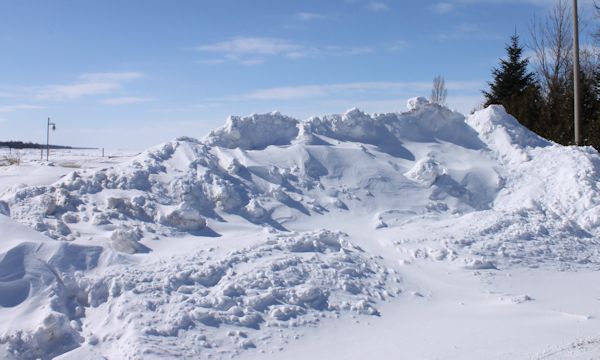Seven Steps to Survival
by Allen A., Survival Blog:

Back in the day, when my hair was a different colour, the Seven Steps to Survival was part of the survival course that I taught. This article will discuss those steps and how I applied them in a recent survival event that I found myself in.
RECOGNITION
Simple as it may sound the first step to surviving is to identify and accept that you have a problem and that it is serious. Denial of your situation or the refusal to accept how serious it is can get you killed or injured. Without acknowledging the nature and seriousness of the situation you will not do what is necessary to survive.
It was blowing about 30-40 MPH and there were soft feathers of snowdrifts forming up to half way across the road at about a 45º angle. Suddenly there was one drift that was darker than the rest and it went all the way across the road. It was as hard as a rock. Hitting that drift threw my car sideways almost as fast as I was going forward. Immediately, I was pioneering my own road in the wilderness.
Trying to steer, once I left the roadway, was useless so I just sat back and enjoyed the ride. All I could so is to let off the gas pedal and wait to stop. Luckily the bank there was rather at a shallow angle so I wound up in a wide ditch that had filled with snow.
When the cloud of snow settled I had snow just above the grill, up to the driver’s side window, and half way up the passenger side doors. Snow had swirled around the rear effectively blocking the rear hatch.
Recognition? Yeah, that was pretty easy for me. I was traveling along one of the more lonely stretches of road in Canada. It was about ten miles from the Alaska border crossing and I had about an hour before the border closed for the night. I had not seen another car or building for a couple of hours and with the border closing in an hour there was no reason for anyone to be traveling this road until the next day. I have traveled that road many times and knew the closest help was at the border. I also knew that the most likely scenario is that the snowplow driver would be the next person down the road and he wouldn’t even show up at the equipment barn for nine or ten hours. I wasn’t walking ten miles in the summer let alone in -7 degrees Fahrenheit, in the dark, and with a 30-40 MPH wind. When you do the math that works out to a windchill of dead.
INVENTORY
After accepting your predicament the next thing you need to do is to take an inventory. In many survival situations you only have what is on you. For me, my EDC in Canada, is a knife, two lights, a Leatherman, two coats, gloves in each coat, military surplus winter gloves, and my fur hat. Sorry, it’s Canada, no gun. I felt naked but technically I wasn’t.
The vehicle I had just packed for a three week trip so I had a pretty good idea what was aboard. Mostly it was my clothes, medical supplies, and a few odds and ends from Costco that my Mom wanted. There was also my food, water, and emergency gear. Each vehicle also gets two flashlights, a fire extinguisher, a tow strap, and a folding shovel. One of these flashlights has a flashing red light option that will come in handy.
Most of my emergency gear is in a rollup tool kit. I keep various tools like a sturdy knife, crescent wrench, vice grips, and screwdrivers. I also have three ways to start fires, large plastic bags, duct tape around the handles of a couple of the tools, a roll of quarters, a flashlight, a small water filter, space blankets and space bags.
I pack my car in what I term a “combat load” and have done so for years. What I mean by this is that my food, water, and emergency gear are all accessible from the front seat. All these years of packing this way finally paid off. First of all I couldn’t get out of the car except by crawling out of the drivers window. Second, if I had left the car it would have been life threatening in that weather. So much as walking once around the vehicle would have chilled me too much. My best option was to stay put. Staying warm was hard enough without trying to warm up after getting cold.
SHELTER
Your primary shelter is your clothing. I had an Army surplus fleece jacket, and an overcoat that was primarily to provide another layer and to keep the wind off my legs above the knees. Each vehicle gets two pair of gloves, just in case. I also keep basic gloves in each coat, because I live in Alaska. In the winter I also carry heavy duty winter gloves and a fur hat.
My most obvious secondary shelter was my vehicle. A snow cave would also have been a good option in my situation if I had been required to leave the vehicle for any reason. There are many expedient shelters that you might come up with depending on your location and season.
As soon as I hit the snow bank my yellow fuel light came on. Normally I don’t let my fuel get that low but it takes about half an hour to get the fifteen gallons off the rear bumper, pumped into the vehicle, and to secure the container and pump back on the rack. The plan was to top off in ten miles after clearing customs. When the light comes on I know I’ve got a good 30 miles to go. I’ve tested that in good weather but after making the thirty miles I figure there was no more to be learned by running it totally dry.
The fuel is low but I’ve got 15 gallons on the bumper. In order to re-fuel, I would have to crawl out the window, dig out the fuel door, dig out the spare tank and fuel pump, and then I’d want to put everything away. I imagine that the car would be half full of snow through the open window before I crawled back in. That wasn’t going to happen.
What I did do is to run the vehicle for ten to fifteen minutes every hour or two. That is all I should be doing in that situation anyway. With snow wrapped 360º around my vehicle the exhaust would be finding its way into the passenger compartment if I had run the engine for very long at any one time.
To give myself some space to work and some extra leg room I moved to the passengers seat. Much easier said than done. The next improvement to my shelter was to get out my space blanket sleeping bag. First I stuffed an extra jacket down on the floor then I had to get my feet into the sleeping bag. The easiest way for me to pull that off was to use my cane to push the bag down and then step into it. Once both feet were inside the bag it was just a matter of working it up till it was past my waist. That was about as far up as I could get it. The regular space blanket then was wrapped over my head and shoulders. I wasn’t going to get heat stroke but I wasn’t going to get frostbite either, which was my goal. It actually worked well enough to get some sleep. I never got cold enough to start shivering so it worked well enough.
SIGNALS
My signal mirror and orange smoke are not appropriate for night signals so they never were deployed. Keep in mind that three of anything is a distress signal and that, in the wilderness, straight lines are not natural. Three fires might make a great night signal and three smokey fires would make a good day signal. These fires need to be widely spaced so as to be definitely three fires yet close enough to be associated. Three lines tramped in the snow but better yet the snow cleared from the ground or branches laid out on the snow in straight lines works well. The bigger, the brighter, the better.
I started out with my emergency flashers as my signal. This worked well. The red and yellow lights reflecting off the snow showed up like a neon sign. After six or seven hours I was concerned about my battery, especially in the cold. One of my vehicle flashlights has a red flashing option. It is a long rectangular light with about half of one side with LEDs. I keep a tourniquet on the passenger side sun visor. I tucked the flashlight behind the tourniquet and then flipped the visor around to the passenger window. This was quite effective and with the light right next to the window it was not particularly irritating. I was even able to go back to sleep. Nobody was going to miss this signal.
Loading...



